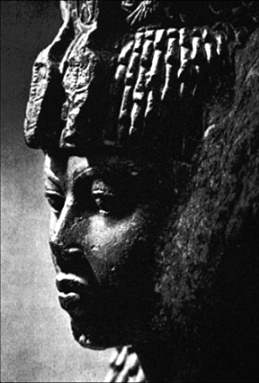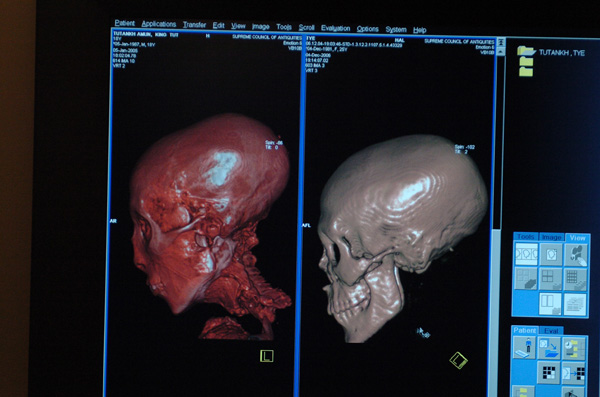Post by bob12 on Feb 23, 2010 13:08:29 GMT 10

At the press conference, I announced that the mummy in tomb KV55 is King Akhenaten who bewildered scientists and researchers either in their search for his mummy or in studying the conditions of his time...CT-Scanners showed that KV55 is the mummy of a 60-year old male. Moreover, the DNA showed that he is the son of King Amenhoteb III, and as we mentioned earlier, the father of King Tutankhamen...The other significant discovery is that the study emphasized that KV55 belongs to a normal male who did not suffer any deformities and his body showed no signs of feminine traits.
en.wikipedia.org/wiki/KV55

The desecrated royal coffin found in Tomb KV55...One scenario, suggested by Nicholas Reeves, is as follows: Akhenaten and his mother, Queen Tiye, were originally entombed at Akhenaten's new capital Akhetaten (modern Amarna) but their mummies were moved to KV55 following the total abandonment of Akhetaten during the reign of Tutankhamun, who was Akhenaten's son. The door to KV55 was sealed with Tutankhamun's name. There the mummies remained for about 200 years, until the tomb was rediscovered by workmen excavating the tomb of Ramesses IX nearby. By this time, Akhenaten was reviled as the "heretic king"; consequently, Queen Tiye's sarcophagus was hastily removed from his defiling presence, except for its surrounding gilded wooden shrine which would have had to be dismantled for removal. Akhenaten's likeness was chiseled off of the shrine's carved relief. Moreover, the gold face mask was ripped from Akhenaten's sarcophagus and his identifying cartouche was removed from its hieroglyphic inscription, thus consigning its occupant to oblivion. As a final insult, a large rock was thrown at the coffin. However, a finely made vulture pectoral—a symbol of royalty in Ancient Egypt—was still found placed around this mummy's head.

The Ancient Egyptian vulture pectoral found on the head of the mysterious Pharaoh in tomb KV55
www.aawsat.com/english/news.asp?section=7&id=19943
Where the Great Akhenaten Lies
20/02/2010
By Zahi Hawass
At a press conference for international media figures held by the Supreme Council of Antiquities last Wednesday at the Egyptian Museum in Cairo, I announced that important [archeological] discoveries had been made that shed more light on the dynasty of the golden pharaoh Tutankhamen. These discoveries marked the beginning of a new chapter in using modern techniques and advanced technology in the field of archeological discoveries.
For many years, Egyptian mummies remained silent, disclosing only a few of their secrets until modern science came and presented to us a new key to the secrets of the mummies, particularly those belonging to the same dynasty. These methods are represented in the deoxyribonucleic acid technique, known as DNA testing, and the CT-Scan. At long last, after a full comprehensive 18-month study of the mummy of King Tutankhamen that is preserved in his tomb in the Valley of the Kings in Luxor, and of other mummies believed to be from the same dynasty, we have set up a DNA laboratory at the basement of the Egyptian Museum and another at Cairo University’s Faculty of Medicine where two teams of distinguished scientists worked. Each team worked separately in its own laboratory away from the other, and both were assisted by German scientists who specialize in studying DNA.
At the press conference, I announced that the mummy in tomb KV55 is King Akhenaten who bewildered scientists and researchers either in their search for his mummy or in studying the conditions of his time. Akhenaten was the first to call for monotheism and sought to change the multiple religions in ancient Egypt. We also confirmed that Akhenaten was the father of King Tutankhamen and this confirmation came after earlier attempts that indicated that in KV55 was most probably the mummy of Akhenaten. But this contradicted studies that indicated that the mummy is of a 25-year old male, which made us think that it could in fact be the mummy of a king that we do not know much about i.e. Smenkhkare who has also baffled scientists. Was he the brother of Tutankhamen? Or was he actually the beautiful queen who perhaps was the co-regent of King Tut in his 17th year of rule and changed her name to Smenkhkare?
Therefore the problem lied in the assumption that the mummy was of a 25-year old male, whilst the studies we carried out with scientists using CT-Scanners showed that KV55 is the mummy of a 60-year old male. Moreover, the DNA showed that he is the son of King Amenhoteb III, and as we mentioned earlier, the father of King Tutankhamen. This discovery has revived historical facts and closed a gap that has been open since the discovery of the mummies of known or unknown kings.
The other significant discovery is that the study emphasized that KV55 belongs to a normal male who did not suffer any deformities and his body showed no signs of feminine traits. Some believed that King Akhenaten might have had feminine traits based on the statues and drawings that depicted him in this way. This was represented in his flabby abdomen and thighs and his feminine chest. It is our duty now to explain such artistic characteristics during Akhenaten's reign and we can find the answer in the Great Hymn to Aten, who was worshipped by Akhenaten, and whose power is depicted in an image that shows the disk of the sun with rays that end in human hands. The Great Hymn to Aten says “you are male and female...”













